The global platycladus orientalis leaf extract market is anticipated to grow from USD 76.9 million in 2025 to approximately USD 140.3 million by 2035, recording an absolute increase of USD 63.4 million over the forecast period. This translates into a total growth of 82.4%, with the market forecast to expand at a CAGR of 6.2% between 2025 and 2035.
The overall market size is expected to grow by nearly 1.8X during the same period, supported by increasing demand for natural herbal extracts, growing interest in traditional Chinese medicine, and rising adoption of botanical ingredients across the global pharmaceutical, cosmetics, and health products industries.
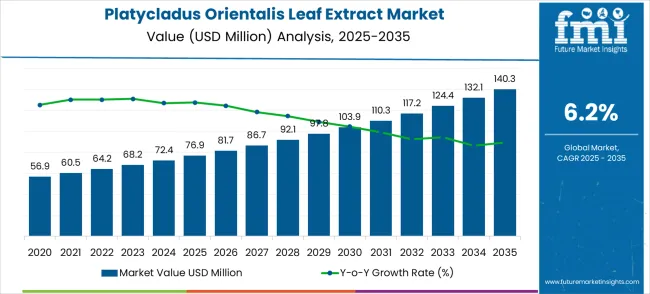
Between 2025 and 2030, the market is projected to expand from USD 76.9 million to USD 103.9 million, resulting in a value increase of USD 27.0 million, which represents 42.6% of the total forecast growth for the decade. This phase of development will be shaped by increasing demand for natural health products, rising consumer awareness of herbal remedies, and growing utilization in traditional Chinese medicine and cosmetic applications.
Botanical extract manufacturers and herbal product specialists are expanding their Platycladus orientalis processing capabilities to address the growing preference for standardized and high-quality herbal extracts in pharmaceutical and cosmetic formulations.
From 2030 to 2035, the market is forecast to grow from USD 103.9 million to USD 140.3 million, adding another USD 36.4 million, which constitutes 57.4% of the ten-year expansion. This period is expected to be characterized by the expansion of ecofriendly extraction technologies, the integration of advanced purification systems for premium platycladus orientalis products, and the development of specialized extract formulations for emerging applications. The growing focus on quality standardization and therapeutic efficacy will drive demand for high-grade platycladus orientalis leaf extracts with enhanced bioactive compound concentrations and improved stability characteristics.
Between 2020 and 2024, the market experienced robust growth, driven by increasing consumer interest in natural health solutions and growing recognition of traditional Chinese medicine's therapeutic potential across global wellness and pharmaceutical applications. The market developed as consumers and manufacturers recognized the potential for platycladus orientalis extracts to provide health benefits while meeting modern quality and safety standards. Technological advancement in extraction methods and standardization processes began focusing the critical importance of maintaining bioactive compound integrity while improving extract purity and commercial viability.
| Metric | Value |
|---|---|
| Estimated Value in (2025E) | USD 76.9 million |
| Forecast Value in (2035F) | USD 140.3 million |
| Forecast CAGR (2025 to 2035) | 6.2% |
Market expansion is being supported by the increasing global demand for natural and botanical ingredients and the corresponding shift toward traditional herbal medicines that can provide therapeutic benefits while meeting consumer preferences for natural health solutions.
Modern pharmaceutical and cosmetics companies are increasingly focused on incorporating platycladus orientalis leaf extracts to enhance product efficacy while satisfying demands for plant-based ingredients and traditional medicine integration. Platycladus orientalis leaf extracts' proven ability to deliver antioxidant properties, anti-inflammatory effects, and hair growth promotion makes them essential ingredients for natural health products and traditional medicine applications.
The growing focus on preventive healthcare and natural wellness solutions is driving demand for high-quality platycladus orientalis leaf extract products that can support distinctive therapeutic capabilities and premium product positioning across traditional medicine, health supplements, and cosmetic categories.
Manufacturer preference for ingredients that combine traditional efficacy with modern scientific validation is creating opportunities for innovative platycladus orientalis implementations in both conventional and emerging health product applications. The rising influence of wellness trends and natural beauty standards is also contributing to increased adoption of premium platycladus orientalis leaf extract products that can provide authentic botanical health characteristics.
The platycladus orientalis leaf extract market represents a niche botanical ingredient opportunity within the broader herbal and traditional medicine sector, with the market projected to grow from USD 76.9 million in 2025 to USD 140.3 million by 2035 at a moderate 6.2% CAGR, an 82% expansion driven by increasing consumer interest in natural health products, traditional Chinese medicine acceptance, and botanical ingredient demand in cosmetics and wellness applications.
This specialized extract, derived from the Oriental arborvitae tree, benefits from documented traditional uses in Chinese medicine for hair growth promotion, anti-inflammatory effects, and antioxidant properties. The partially water-soluble form leads with 27.3% market share due to its superior formulation compatibility in aqueous-based products. At the same time, Chinese medicine applications dominate demand given the extract's established role in traditional therapeutic preparations. Geographic growth is strongest in China (8.4% CAGR) as the source market for both cultivation and traditional medicine applications, though the overall market size remains relatively small and specialized.
Pathway A - Traditional Chinese Medicine Applications. The dominant application segment drives demand from traditional medicine practitioners and modern TCM manufacturers seeking standardized, quality-assured herbal ingredients. Companies developing pharmaceutical-grade extracts with validated traditional formulations and therapeutic consistency will capture this foundational market segment. Expected revenue pool: USD 50-70 million.
Pathway B - Partially Water-Soluble Formulations. The leading solubility category offers optimal formulation compatibility for both traditional preparations and modern product development. Providers developing enhanced water-soluble extracts with improved bioavailability and stability will maintain technology leadership in this dominant segment. Opportunity: USD 35-50 million.
Pathway C - Hair Care and Cosmetic Applications. Growing consumer interest in natural beauty products and traditional hair growth remedies creates expanding opportunities beyond conventional medicine. Developing cosmetic-grade extracts with clinically validated hair growth benefits and premium formulation properties addresses this higher-margin market segment. Revenue uplift: USD 25-40 million.
Pathway D - Geographic Expansion in China and Asia. China's position as both the primary cultivation region and largest consumer market creates substantial opportunities for extract processors. Local cultivation partnerships, processing scale economies, and domestic market penetration strategies enable capture of this highest-growth regional opportunity. Pool: USD 40-60 million.
Pathway E - Standardized Extract Development. Modern applications require consistent bioactive compound concentrations and quality certifications. Companies investing in advanced extraction technologies, standardization processes, and analytical validation will create competitive advantages in quality-sensitive pharmaceutical and cosmetic applications. Expected upside: USD 20-35 million.
Pathway F - Health Supplement and Nutraceutical Markets. Western markets show growing interest in traditional herbal remedies for wellness applications. Developing standardized supplements with clinical research support and regulatory compliance enables market expansion beyond conventional medicine into mainstream health product channels. USD 15-30 million.
Pathway G - Eco-friendly Cultivation and Supply Chain Integration. Market growth requires a reliable raw material supply and eco-friendly harvesting practices. Companies developing integrated cultivation operations with quality control and traceability will secure supply chain advantages while supporting premium positioning in environmentally conscious markets. Pool: USD 10-20 million.
Pathway H - Research and Clinical Validation. Modern applications benefit from scientific validation of traditional uses and therapeutic mechanisms. Investment in clinical research, bioactive compound identification, and efficacy studies creates intellectual property advantages and supports premium pricing in evidence-based market segments. Expected revenue: USD 8-15 million.
The market is segmented by solubility, application, and region. By solubility, the market is divided into partially soluble in water and insoluble in water. Based on application, the market is categorized into Chinese medicine, health products, cosmetics, and others. Regionally, the market is divided into North America, Europe, East Asia, South Asia & Pacific, Latin America, and the Middle East & Africa.
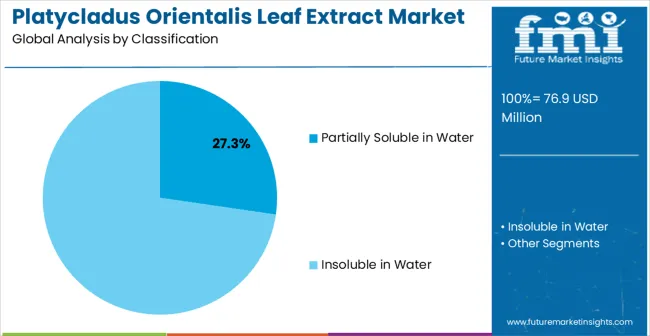
The partially soluble in water segment is projected to account for 27.3% of the market in 2025, reaffirming its position as the leading solubility category. Pharmaceutical manufacturers and cosmetic formulators increasingly utilize partially water-soluble platycladus orientalis extracts for their superior formulation compatibility, consistent bioavailability characteristics, and ease of integration in aqueous-based products across diverse health and beauty applications.
Partially water-soluble extract technology's balanced solubility profile and reliable stability directly address the formulation requirements for effective ingredient incorporation and efficient bioactive delivery in commercial product development operations.
This solubility segment forms the foundation of modern botanical extract applications, as it represents the technology with the greatest formulation versatility and established compatibility across multiple product development systems.
Manufacturer investments in solubility optimization and extract standardization continue to strengthen adoption among product formulators. With companies prioritizing ingredient functionality and formulation stability, partially water-soluble platycladus orientalis extracts align with both efficacy objectives and manufacturing convenience requirements, making them the central component of comprehensive botanical ingredient strategies.
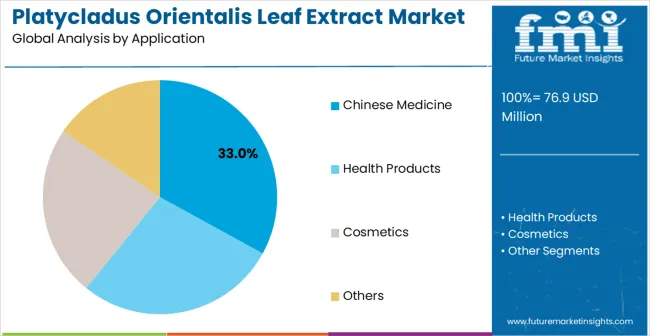
Chinese medicine applications are projected to 33.0% share of platycladus orientalis leaf extract demand in 2025, underscoring their critical role as the primary application for traditional herbal remedies in Chinese medicine practice and conventional healthcare systems.
Conventional medicine practitioners prefer platycladus orientalis leaf extracts for their established therapeutic properties, historical usage validation, and ability to maintain consistent medicinal effects while supporting traditional treatment protocols during healthcare applications. Positioned as essential ingredients for authentic conventional medicine preparations, platycladus orientalis leaf extracts offer both therapeutic effectiveness and cultural authenticity advantages.
The segment is supported by continuous growth in traditional medicine acceptance and the growing availability of standardized herbal extracts that enable enhanced therapeutic consistency and quality assurance at the practitioner level.
Additionally, conventional medicine practitioners are investing in quality-assured herbal ingredients to support premium treatment offerings and patient confidence. As traditional Chinese medicine continues to gain global recognition and practitioners seek superior herbal ingredient solutions, Chinese medicine applications will continue to dominate the application landscape while supporting therapeutic advancement and traditional medicine modernization strategies.
The market is advancing steadily due to increasing consumer interest in natural health products and growing demand for botanical ingredients that emphasize traditional therapeutic benefits across Chinese medicine and cosmetic applications. However, the market faces challenges, including supply chain dependencies on specific growing regions, seasonal availability variations affecting raw material supply, and competition from synthetic alternatives. Innovation in eco-friendly cultivation practices and standardized extraction technologies continues to influence market development and expansion patterns.
The growing adoption of platycladus orientalis leaf extracts in natural cosmetics and hair care applications is enabling product manufacturers to develop formulations that provide distinctive therapeutic benefits while commanding premium positioning and enhanced natural product characteristics. Advanced applications provide superior hair growth promotion while allowing more sophisticated cosmetic development across various beauty categories and consumer segments. Manufacturers are increasingly recognizing the competitive advantages of botanical ingredient positioning for premium cosmetic development and natural beauty market penetration.
Modern platycladus orientalis leaf extract suppliers are incorporating eco-friendly farming practices, advanced extraction technologies, and quality standardization systems to enhance extract purity, improve supply chain reliability, and meet industry demands for consistent and high-quality botanical ingredients. These programs improve the quality of product while enabling new applications, including standardized therapeutic preparations and premium cosmetic formulations. Advanced sustainability integration also allows suppliers to support premium market positioning and environmental responsibility beyond traditional commodity herbal extracts.
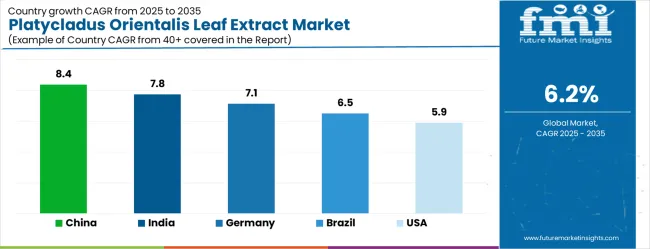
| Country | CAGR (2025-2035) |
|---|---|
| China | 8.4% |
| India | 7.8% |
| Germany | 7.1% |
| Brazil | 6.5% |
| USA | 5.9% |
| UK | 5.3% |
| Japan | 4.7% |
The market is experiencing robust growth globally, with China leading at an 8.4% CAGR through 2035, driven by the rapidly expanding traditional Chinese medicine sector, massive investments in herbal medicine modernization, and increasing adoption of standardized botanical extracts. India follows at 7.8%, supported by the growing herbal medicine industry, rising natural health product demand, and expanding Ayurvedic medicine integration.
Germany shows growth at 7.1%, focusing advanced botanical extraction technology and premium herbal product manufacturing. Brazil records 6.5%, focusing on emerging natural health applications and botanical ingredient development.
The USA demonstrates 5.9% growth, prioritizing natural health product innovation and botanical supplement advancement. The UK exhibits 5.3% growth, supported by natural cosmetics development and advanced herbal product capabilities. Japan shows 4.7% growth, focusing precision botanical processing excellence and high-quality herbal extract production.
The report covers an in-depth analysis of 40+ countries; top-performing countries are highlighted below.
China is projected to exhibit exceptional growth with a CAGR of 8.4% through 2035, driven by the rapidly expanding traditional Chinese medicine sector and massive government investments in herbal medicine modernization across major production regions. The country's growing botanical extract industry and increasing adoption of standardized herbal processing technologies are creating substantial demand for high-quality platycladus orientalis products in both traditional medicine and modern health applications. Major herbal extract manufacturers and traditional medicine companies are establishing comprehensive cultivation and processing capabilities to serve both domestic consumption and export markets.
India is expanding at a CAGR of 7.8%, supported by the growing herbal medicine industry, increasing natural health product demand, and expanding Ayurvedic medicine integration applications. The country's developing botanical extract ecosystem and expanding traditional medicine capabilities are driving demand for quality herbal extracts across both conventional medicine and modern wellness applications. International botanical companies and domestic herbal extract manufacturers are establishing comprehensive distribution and processing capabilities to address growing market demand for standardized herbal ingredients.
Germany is projected to grow at a CAGR of 7.1% through 2035, driven by the country's advanced botanical extraction technology sector, premium herbal product manufacturing capabilities, and leadership in natural ingredient solutions. Germany's sophisticated pharmaceutical culture and willingness to invest in high-performance botanical technologies are creating substantial demand for both standard and specialized platycladus orientalis extract varieties. Leading technology companies and herbal product manufacturers are establishing comprehensive innovation strategies to serve both European markets and growing international demand.
Brazil is projected to grow at a CAGR of 6.5% through 2035, supported by the country's expanding natural health sector, growing botanical ingredient applications, and increasing adoption of herbal medicine requiring high-quality plant extracts. Brazilian manufacturers and international companies consistently seek reliable botanical ingredients that enhance product effectiveness for both domestic applications and regional markets. The country's position as a regional natural products hub continues to drive innovation in herbal extraction applications and quality standards.
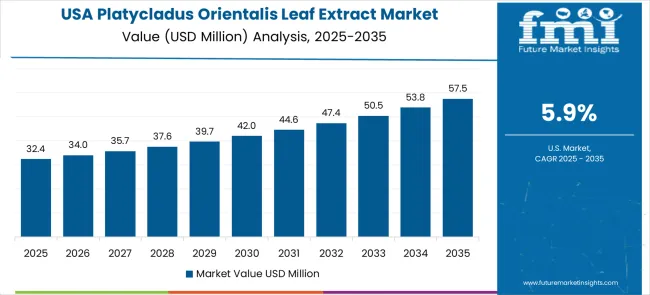
The United States is projected to grow at a CAGR of 5.9% through 2035, supported by the country's advanced natural health sector, botanical ingredient innovation capabilities, and established leadership in dietary supplement solutions. American health product companies and cosmetic manufacturers prioritize quality, efficacy, and regulatory compliance, making platycladus orientalis leaf extracts valuable ingredients for both domestic production and premium product development. The country's comprehensive research capabilities and technical expertise support continued market development.
The United Kingdom is projected to grow at a CAGR of 5.3% through 2035, supported by the country's natural cosmetics development sector, advanced herbal product capabilities, and established expertise in botanical ingredient solutions. British manufacturers' focus on innovation, quality, and sustainability creates steady demand for premium Platycladus orientalis leaf extract ingredients. The country's attention to product effectiveness and natural formulation drives consistent adoption across both traditional herbal products and emerging cosmetic applications.
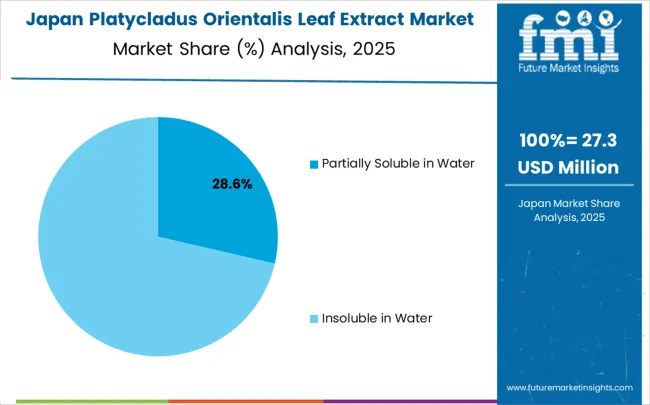
Japan is projected to grow at a CAGR of 4.7% through 2035, supported by the country's precision botanical processing excellence, advanced herbal technology expertise, and established reputation for producing superior natural ingredients while working to enhance extraction efficiency capabilities and develop next-generation herbal processing technologies. Japan's botanical extract industry continues to benefit from its reputation for producing high-quality natural products while focusing on innovation and processing precision.
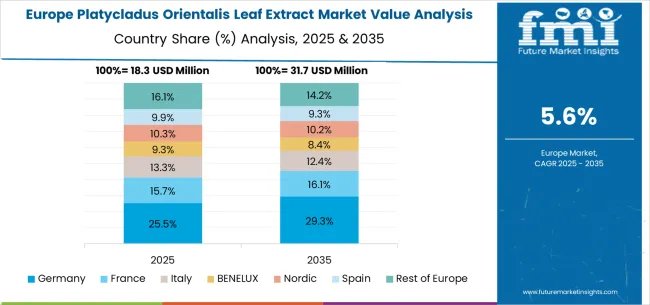
The platycladus orientalis leaf extract market in Europe is projected to grow from USD 19.7 million in 2025 to USD 34.6 million by 2035, registering a CAGR of 5.8% over the forecast period. Germany is expected to maintain its leadership position with a 36.2% market share in 2025, remaining stable at 36.0% by 2035, supported by its advanced botanical extraction technology sector, precision herbal product manufacturing industry, and comprehensive innovation capabilities serving European and international markets.
The United Kingdom follows with a 24.8% share in 2025, projected to reach 25.1% by 2035, driven by natural cosmetics development programs, advanced herbal product capabilities, and growing focus on botanical ingredient solutions for premium applications. France holds a 17.6% share in 2025, expected to maintain 17.4% by 2035, supported by cosmetics industry demand and natural product applications, but facing challenges from market competition and economic considerations.
Italy commands an 11.9% share in 2025, projected to reach 12.1% by 2035, while Spain accounts for 6.3% in 2025, expected to reach 6.5% by 2035. The Netherlands maintains a 3.2% share in 2025, growing to 3.3% by 2035. The Rest of Europe region, including Nordic countries, Eastern Europe, Belgium, Switzerland, and Austria, is anticipated to hold 14.2% in 2025, declining slightly to 13.8% by 2035, attributed to mixed growth patterns with moderate expansion in some natural products markets balanced by slower growth in smaller countries implementing botanical ingredient development programs.
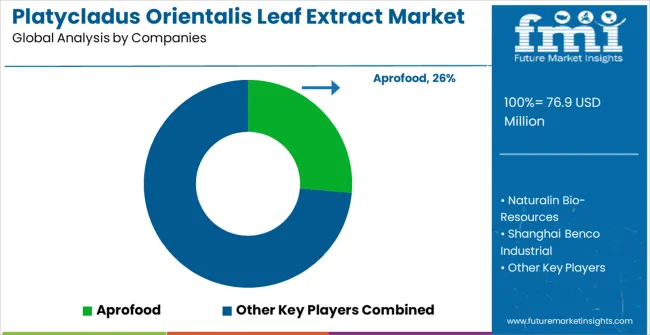
The market is characterized by competition among established botanical extract companies, specialized herbal product manufacturers, and integrated natural ingredient suppliers. Companies are investing in advanced extraction technologies, quality standardization systems, eco-friendly cultivation programs, and comprehensive technical support capabilities to deliver consistent, high-quality, and therapeutic-grade platycladus orientalis leaf extract products. Innovation in bioactive compound optimization, extraction efficiency enhancement, and customized formulation solutions is central to strengthening market position and customer satisfaction.
Aprofood leads the market with a strong focus on natural ingredient innovation and comprehensive botanical extract solutions, offering sophisticated platycladus orientalis leaf extract products with focus on quality assurance and application versatility excellence. Naturalin Bio-Resources provides integrated botanical extraction capabilities with a focus on standardized herbal ingredients and global distribution networks.
Shanghai Benco Industrial delivers advanced natural product technology with a focus on innovation and premium extract development. Xi'an Tianguangyuan Biotechnology specializes in herbal biotechnology solutions with focus on technical expertise and extraction optimization.
Shaanxi Xintianyu Biotechnology focuses on botanical processing technologies and advanced herbal extraction systems. Sanyuan Tianyu Biological Products emphasizes biological extract expertise with a focus on quality manufacturing and product standardization.
| Items | Values |
|---|---|
| Quantitative Units (2025) | USD 76.9 million |
| Solubility | Partially Soluble in Water, Insoluble in Water |
| Application | Chinese Medicine, Health Products, Cosmetics, Others |
| Regions Covered | North America, Europe, East Asia, South Asia & Pacific, Latin America, Middle East & Africa |
| Countries Covered | United States, Canada, United Kingdom, Germany, France, China, Japan, South Korea, India, Brazil, Australia and 40+ countries |
| Key Companies Profiled | Aprofood, Naturalin Bio-Resources, Shanghai Benco Industrial, Xi'an Tianguangyuan Biotechnology, Shaanxi Xintianyu Biotechnology, Sanyuan Tianyu Biological Products, and Xi'an Tianxingjian Natural Bio-Products |
| Additional Attributes | Dollar sales by solubility and application, regional demand trends, competitive landscape, technological advancements in botanical extraction, quality standardization development initiatives, therapeutic efficacy optimization programs, and traditional medicine integration strategies |
The global ultra high purity (uhp) valve market is estimated to be valued at USD 615.4 million in 2025.
The market size for the ultra high purity (uhp) valve market is projected to reach USD 1,155.2 million by 2035.
The ultra high purity (uhp) valve market is expected to grow at a 6.5% CAGR between 2025 and 2035.
The key product types in ultra high purity (uhp) valve market are steel valve and fluoropolymers valve.
In terms of application, semiconductor processing segment to command 52.8% share in the ultra high purity (uhp) valve market in 2025.






Our Research Products

The "Full Research Suite" delivers actionable market intel, deep dives on markets or technologies, so clients act faster, cut risk, and unlock growth.

The Leaderboard benchmarks and ranks top vendors, classifying them as Established Leaders, Leading Challengers, or Disruptors & Challengers.

Locates where complements amplify value and substitutes erode it, forecasting net impact by horizon

We deliver granular, decision-grade intel: market sizing, 5-year forecasts, pricing, adoption, usage, revenue, and operational KPIs—plus competitor tracking, regulation, and value chains—across 60 countries broadly.

Spot the shifts before they hit your P&L. We track inflection points, adoption curves, pricing moves, and ecosystem plays to show where demand is heading, why it is changing, and what to do next across high-growth markets and disruptive tech

Real-time reads of user behavior. We track shifting priorities, perceptions of today’s and next-gen services, and provider experience, then pace how fast tech moves from trial to adoption, blending buyer, consumer, and channel inputs with social signals (#WhySwitch, #UX).

Partner with our analyst team to build a custom report designed around your business priorities. From analysing market trends to assessing competitors or crafting bespoke datasets, we tailor insights to your needs.
Supplier Intelligence
Discovery & Profiling
Capacity & Footprint
Performance & Risk
Compliance & Governance
Commercial Readiness
Who Supplies Whom
Scorecards & Shortlists
Playbooks & Docs
Category Intelligence
Definition & Scope
Demand & Use Cases
Cost Drivers
Market Structure
Supply Chain Map
Trade & Policy
Operating Norms
Deliverables
Buyer Intelligence
Account Basics
Spend & Scope
Procurement Model
Vendor Requirements
Terms & Policies
Entry Strategy
Pain Points & Triggers
Outputs
Pricing Analysis
Benchmarks
Trends
Should-Cost
Indexation
Landed Cost
Commercial Terms
Deliverables
Brand Analysis
Positioning & Value Prop
Share & Presence
Customer Evidence
Go-to-Market
Digital & Reputation
Compliance & Trust
KPIs & Gaps
Outputs
Full Research Suite comprises of:
Market outlook & trends analysis
Interviews & case studies
Strategic recommendations
Vendor profiles & capabilities analysis
5-year forecasts
8 regions and 60+ country-level data splits
Market segment data splits
12 months of continuous data updates
DELIVERED AS:
PDF EXCEL ONLINE
Olive Leaf Extract Market
Eucommia Leaf Extract Market Size and Share Forecast Outlook 2025 to 2035
Red Vine Leaf Extract Market Size and Share Forecast Outlook 2025 to 2035
Camellia Sinensis Leaf Extract Market
Leaf Spring Assembly Market Size and Share Forecast Outlook 2025 to 2035
Leaf Rolling Machine Market Size and Share Forecast Outlook 2025 to 2035
Extraction Kits Market Analysis - Size, Share, and Forecast Outlook 2025 to 2035
Extracts and Distillates Market
Bay Leaf Oil Market Size and Share Forecast Outlook 2025 to 2035
Bay Leaf Market Size and Share Forecast Outlook 2025 to 2035
Sage Extract Market Size and Share Forecast Outlook 2025 to 2035
Fume Extractor Market Size and Share Forecast Outlook 2025 to 2035
Meat Extracts Market Size and Share Forecast Outlook 2025 to 2035
Kale Extract Skincare Market Size and Share Forecast Outlook 2025 to 2035
Wine Extract Market Size and Share Forecast Outlook 2025 to 2035
Amla Extract Market Analysis - Size, Share, and Forecast Outlook 2025 to 2035
Dust Extractor Market Growth – Trends & Forecast 2025 to 2035
Data Extraction Software Market
Lipid Extraction Kit Market Size and Share Forecast Outlook 2025 to 2035
Peony Extract Brightening Creams Market Analysis - Size, Share, and Forecast Outlook 2025 to 2035

Thank you!
You will receive an email from our Business Development Manager. Please be sure to check your SPAM/JUNK folder too.
Chat With
MaRIA